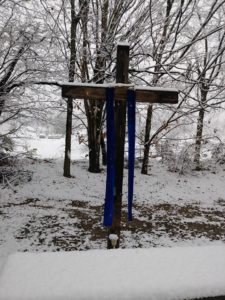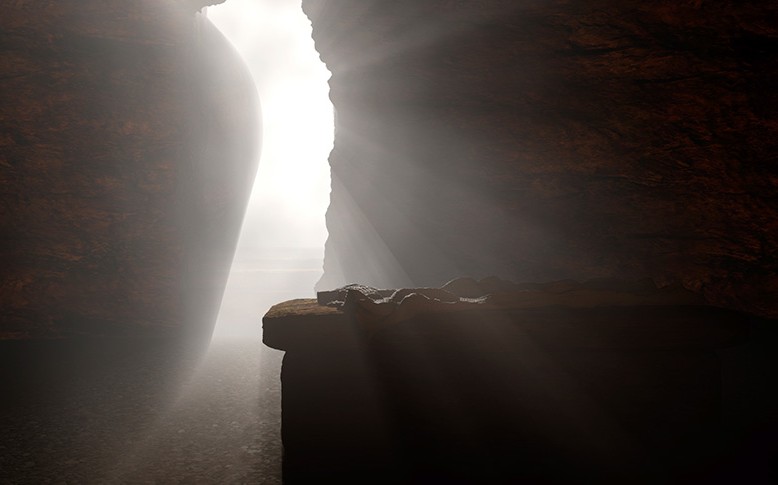By: Brian G. Chilton | April 2, 2018
Easter is my favorite holiday. It is nice because of the warming weather, the blooming of flowers, the greening of the grass, and the growth of leaves on the trees. Everything looks dead during the winter, but everything seems to come to life around Easter.
 The best reason for my love of Easter is that it is the holiest day of the year for Christians. Easter
The best reason for my love of Easter is that it is the holiest day of the year for Christians. Easter represents the day that Jesus physically and literally rose from the dead. While I am Southern Baptist, I personally practice liturgical spiritual disciplines. I credit Dr. T. Perry Hildreth, professor at Gardner-Webb, for turning me to these practices. That is to say, I have a cross in my prayer garden that bears cloths representing the colors of the church year. The green cloth represents ordinary time when no special occasion is celebrated. Red is used for Pentecost, Holy Week, and special church days. Purple is used during the time of lent. I personally use blue for Advent (the time before Christmas) although purple is the standard color. White is used for Christmas and the Easter season.
represents the day that Jesus physically and literally rose from the dead. While I am Southern Baptist, I personally practice liturgical spiritual disciplines. I credit Dr. T. Perry Hildreth, professor at Gardner-Webb, for turning me to these practices. That is to say, I have a cross in my prayer garden that bears cloths representing the colors of the church year. The green cloth represents ordinary time when no special occasion is celebrated. Red is used for Pentecost, Holy Week, and special church days. Purple is used during the time of lent. I personally use blue for Advent (the time before Christmas) although purple is the standard color. White is used for Christmas and the Easter season.
Interestingly, the white cloth does not remain on the cross only for Easter. It remains on the cross for 40 days. Why? Jesus just did not appear to his disciples on one day. He appeared to them numerous times over the course of 40 days!!! The following marks a chronological listing of Jesus’s resurrected appearances over this time. While skeptics claim that these appearances are irreconcilable in their descriptions, I do not see how that is the case. While Jesus most certainly appeared to many more people than Scripture indicates, a strong case for Jesus’s resurrection can be made by the numerous individuals who saw Jesus alive after his death over the course of 40 days.
- Mary Magdalene: Early Easter morning (Jn. 20:11-18). First, Jesus appeared to Mary Magdalene. Mary was not the ideal choice if one was wanting to invent a story for two reasons: Mary was a woman, and Mary had at one time been demonically possessed (Lk. 8:2). The testimony of women wasn’t trusted in antiquity. Add the fact that Mary had something in her past, that makes a bizarre and in fact embarrassing claim for the church, something that holds great historical and apologetic weight. In his infinite wisdom, Jesus appeared to a woman who had faithfully served him despite whatever it was in her past.
- Women at the Tomb: Early Easter morning (Matt. 28:8-10). It appears that the women first accompanied Mary Magdalene. The women went to tell Peter and John. Peter and John came with Mary back to the tomb (Jn. 20:3-10). Perhaps the women stayed back as Peter, John, and Mary Magdalene stepped into the tomb. After Peter and John left, Jesus appeared to Mary, and then to the other women at the tomb. Again, this would have been an embarrassing fact for the early church. Jesus first appeared to women instead of the men.
- Peter: Early to mid-day Easter (Lk. 24:34; 1 Cor. 15:5). Luke 24:34 and 1 Corinthians 15:5 both indicate that Jesus met with Peter in a private meeting sometime between Jesus’s appearance to the women at the tomb and his later appearances to the disciples at Emmaus and his primary disciples. Notice especially the language of Luke 24:34. When the disciples heard from the Emmaus disciples, they said, “The Lord has truly been raised and has appeared to Simon!” Then they began to describe what had happened on the road . . .” (Lk. 24:34). 1 Corinthians 15:5 also notes that Jesus met privately with Peter, named by his Aramaic name Cephas (1 Cor. 15:5), before meeting with the disciples.
- The Emmaus Disciples: Late Easter afternoon (Lk. 24:13-32). Later in the day on Easter, Jesus appeared to two disciples walking from Jerusalem to Emmaus. Some believe that these two disciples may have been a married couple with only the husband, Cleopas (Lk. 24:18) being named. They did not realize that it was Jesus until they welcomed him into their home. They then ran back to Jerusalem to tell the disciples.
- The Eleven w/out Thomas: Easter evening (Lk. 24:36-49; Jn. 20:19-23). Luke 24 and John 20 indicate that Jesus met with the disciples later in the evening. Can you imagine what was going through the disciples’ minds as they heard reports of Jesus appearing to people, yet they had not seen him themselves? They had to wait awhile before they could see Jesus for themselves. Thomas was not present. This is a major question I have concerning Thomas: Where was he? Was he pursuing other work since Jesus had died? He was gone for nearly a week. Where was he? Where did he go?
- The Eleven w/Thomas: Next Sunday after Easter (Jn. 20:24-29). Thomas had heard the reports that Jesus had risen. He did not believe them. He would not believe unless he saw Jesus for himself. He would the next Sunday as Jesus appeared to the disciples with Thomas in their presence. Thomas no longer denied Jesus’s resurrection. He believed.
- 500 or More at One Time (1 Cor. 15:6). It could be that this meeting is the same as number 11 on our list. However, we do not have enough evidence to know when this gathering took place. Suffice to say, Jesus appeared to a large gathering of disciples. He was seen of over 500 disciples at one time. Personally, since only men were numbered in antiquity, I think you see the same effect with this number that you would with the feeding of the 5,000. I think it is possible that there were 1,500 or even perhaps 2,000 that witnessed the risen Jesus at this encounter.
- James and Perhaps Other Family Members (1 Cor. 15:7). James had a private meeting with his risen brother. I think it is strongly probable that Jesus also met with his other family members at this time.
- Reinstatement of Peter: The Meeting with the Seven (Jn. 21:1-23). The disciples went back to Galilee for a period before they were to go back to Jerusalem for the ascension and Pentecost. During an intimate meeting near the shore of the Sea of Galilee, Jesus reinstated Peter before six other individuals.
- 72 Apostles Implied (1 Cor. 15:7). In 1 Corinthians 15:7, a distinction is made between Jesus’s appearance to the Twelve (1 Cor. 15:5) and his appearance to “all the apostles” (1 Cor. 15:7). Jesus had twelve disciples, but he also had a larger body of disciples outside of the twelve. Luke notes that Jesus appointed “seventy-two others, and he sent them ahead of him in pairs to every town and place where he himself was a bout to go” (Lk. 10:10). I think this means that Jesus appeared to all the seventy-two disciples that he had previously commissioned while in Galilee.
- Great Commission Gathering (Matt. 28:16-20). Some people confuse the Great Commission gathering with the ascension. This is simply not the case. The ascension transpired on the Mount of Olives in Jerusalem. Jesus’s meeting with the disciples, and most likely many others, when he gave the Great Commission happened while they were in Galilee (Matt. 28:16), thereby making this occurrence different than the ascension event.
- Ascension (Ac. 1:1-11). Jesus’s final public post-resurrection event happened at his ascension. Being that the ascension happened in the bustling town of Jerusalem on a prominent mount in the area, it would be difficult to ascertain just how many people witnessed the ascension of Jesus.
- Appearance to Paul (Ac. 9:1-9). Lastly, Jesus appeared after his ascension to Paul. Saul Paul was a man who was an antagonist to the Christian faith. However, the post-resurrection appearance of Jesus to Paul transformed him from a skeptic to a passionate communicator of Christian truth.
So, what apologetic truths can be found from these appearances? A lot! But, to simplify, we see that Jesus’s post-resurrection appearances:
- Had embarrassing factors (seen first by women).
- Transformed skeptics into believers (Thomas, James, and Paul).
- Was not a one-time event but witnessed by many over the course of 40 days.
- Was publicly seen by multiple people which dispels any rumors of hallucinations.
- Allowed those who were weak to become strong in their faith that Jesus had risen (e.g., Peter).
I believe that Jesus appeared to many others during this period. Jesus’s resurrection was not a hallucination. His appearance was not a one-time showing. The fact that Jesus appeared after his resurrection as he did verifies that Jesus had indeed defeated death. This is something that we should not only celebrate for the forty days of Easter, but 365 days a year!
About the Author
 Brian G. Chilton is the founder of BellatorChristi.com and is the host of The Bellator Christi Podcast. He received his Master of Divinity in Theology from Liberty University (with high distinction); his Bachelor of Science in Religious Studies and Philosophy from Gardner-Webb University (with honors); and received certification in Christian Apologetics from Biola University. Brian is currently in the Ph.D. program in Theology and Apologetics at Liberty University. Brian has been in the ministry for over 15 years and serves as the pastor of Huntsville Baptist Church in Yadkinville, North Carolina.
Brian G. Chilton is the founder of BellatorChristi.com and is the host of The Bellator Christi Podcast. He received his Master of Divinity in Theology from Liberty University (with high distinction); his Bachelor of Science in Religious Studies and Philosophy from Gardner-Webb University (with honors); and received certification in Christian Apologetics from Biola University. Brian is currently in the Ph.D. program in Theology and Apologetics at Liberty University. Brian has been in the ministry for over 15 years and serves as the pastor of Huntsville Baptist Church in Yadkinville, North Carolina.
© 2018. BellatorChristi.com.






[…] Originally posted at: The 40 Days of Easter […]